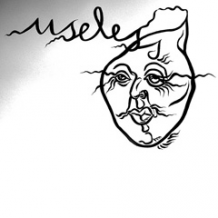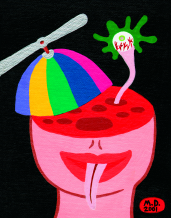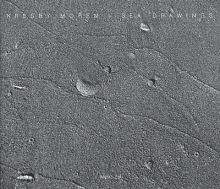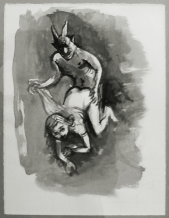| Umělec magazine 2010/1 >> Goshka Macuga: The Nature of the Beast. Whitechapel Gallery, London. | List of all editions. | ||||||||||||
|
|||||||||||||
Goshka Macuga: The Nature of the Beast. Whitechapel Gallery, London.Umělec magazine 2010/101.01.2010 Lizzy Le Quesne | solutions | en cs de |
|||||||||||||
|
In her installation The Nature of the Beast London based Polish artist and 2008 Turner Prize nominee Goshka Mucuga has created a unique venue for public gatherings. Boldly setting her own sculpture alongside one of Picasso’s greatest masterpieces, and an assortment of past and current documentation, this forceful new work speaks of complex, historically informed, human drives. The work explores the relationship between aesthetics and politics and subtly places the viewer in confrontation with their own fallibility and responsibility as a member of society, and potentially operational element of culture.
Macuga’s is the first of the new year-long Bloomberg Commissions for the newly renovated Whitechapel Gallery, which are specifically intended to support works that in some way explore and elucidate the history of the site of the gallery. Macuga’s response to the Bloomberg notion takes a colourful episode from the museum’s history as its starting point and manages to draw from it multifarious and tangible threads, both to the present political and cultural environment and to an unnerving aspect of human nature. In 1939 Picasso’s masterpiece Guernica was displayed at the Whitechapel in its only UK appearance, as part of an exhibition specifically organised to drum up support, aid - and in the event volunteer fighters - against the fascists in the Spanish Civil War. By quasi-re-enacting this event in her new work, Macuga asks the public once again to step up and engage with community endeavours, in the context of the great Picasso image, and underlines the Whitechapel’s community incentive. The Whitechapel Gallery is located in East London, traditionally the poorest and most industrial part of the city, and home to various immigrant and refugee groups as well as British workers. The former library was converted into a public art gallery in 1901 in order to bring important contemporary art to London’s poor, and has always had a sense of equality and openness in its identity and remit. With no entrance fee and an extensive programme of community and education work it remains dedicated to this purpose; and Macuga’s installation highlights and extends this mission. At its best, as with the function of installation art, it informs and provokes and positions the viewer in direct personal and principled relationship with the world. It also proclaims the power of visual art to convey profoundly emotive and effective moral and political messages that can speak effectively to people of all walks of life. Macuga manages to draw connections between official people and acts (from Colin Powell and the United Nations, grand international art exhibitions) and the most unofficial groups (contemporary anarchist groups, amateur artists) in such a way that the thoughtful viewer is inescapably implicated and forced to consider their own relationship to these various standpoints and activities, and to question the extent of their own potential empowerment regarding the state of the world in which they, we, live. The installation is enormously complex and incorporates a range of disparate elements and materials that in themselves span almost a century of Modern and contemporary art techniques and approaches. The works moves from 2-D depiction, to sculptural object, to moving image, to interactive environment, documentary, and finally to participatory event. It includes a work of the highest classic Modern status (a life sized tapestry of Picasso’s iconic painting Guernica) set alongside a sculpture by Macuga (a bronze statue of Colin Powell in Cubist style), a documentary film (about the Spanish Civil War), a hand woven Middle Eastern rug (addressing the UN, and depicting Iraq and military paraphernalia), a conference table and chairs with office style curtains and carpeting, several pieces of archival material relating to political and cultural events from the 1930’s to the present and a newspaper produced by Macuga which reproduces some of this material alongside an informative interview with the artist and her curator. The newspaper also prints the artist’s invitation for any group, political or otherwise, to use the space and furniture to hold discussion meetings free of charge. This significant element shifts the work from being primarily “viewable”, i.e. passive and symbolic into becoming the site for un-preconceived, genuine interaction between members of the public. It creates a space for people to meet and interact in a genuine way, to discuss real matters and perhaps reach conclusions that might genuinely effect their lives and thus the communities in which they live. The participants are invited to take part in the continuing history of the space, while being set against the complex political and historical and moral agitations created by the installation itself, and in full view and hearing of the visiting public. In itself this is a political gesture, forcing the meetings to be entirely open and public. All of the material interlinks around themes of power, destructive forces in the service of power, collective and individual responsibility and the role of creative and artistic endeavour in both culture and politics. The various elements loosely hang together through overlapping points of reference. There is no tight or immediately obvious fit but they are all connected enough to jangle against each other in an unpredictably and excitingly coherent way. At first sight the installation appears as some kind of corporate boardroom, with the round table of sleek but functional modernist design, surrounded by chrome and leather armchairs placed centre stage before the giant tapestry of Picasso’s Guernica. The bronze bust appears like some decorative art piece in any large commercial foyer, and the glaring electric blue curtain along one wall behind the tapestry, is redolent of brisk, corporate gloss. This is augmented by the formality of the room itself, exposed brick walls lined with moulded, painted columns. The feeling on entering is like that of coming into some space of austere authority, of challenge, and judgement – a courtroom, or a boardroom. I sensed a memory of the discomfort of a rarely worn “interview suit”, and a shiver of recognition that I might be required to think and somehow account for myself. The full size tapestry version of Guernica is wide and imposing in stark blacks, whites and greys. It is stunning and brutal in its expression of agony, terror and despair. The garish, merciless blue curtain behind it even sets it off to fiercer effect. As one reads the information placed beneath the glass surface of the table, in the newspaper, and included in the film, and looks more closely at the objects in the room, the ethical questions and overbearing weight of cultural contexts emerge, revealing a loosely interwoven network of specific human actions and attitudes that are both seriously shameful and challenging to us today. Beyond re-staging the grand moment in the Whitechapel’s history when the gallery displayed Picasso’s masterpiece, Macuga addresses a more recent development in the political adventures of the artwork. In 1985 the tapestry was commissioned by Nelson Rockerfeller in 1985, created by Picasso in collaboration with a French weaving firm, and was lent to be hung in the United Nations Headquarters in New York, as a constant warning against unbridled military aggression, a reminder of the horrors of war, and as a backdrop for major UN announcements. On the occasion of Colin Powell’s 2003 speech to the UN Security Council which sought UN endorsement for a pre-emptive strike against Iraq, the tapestry was significantly covered by a blue curtain. Macuga has placed the tapestry in front of a heavy curtain of bright blue fabric. She also provides a full transcription of Powell’s eloquent speech which masterfully draws strong conclusions for war from inconclusive intelligence. The UN’s covering of the image for this fateful delivery represents a deliberate turning away from the ugliness of military aggression, and highlights the duplicitous-ness and extraordinarily delicate manoeuvring of Colin Powell’s position. Macuga’s own bronze sculpture of the then US Secretary speaks of Powell’s pivotal role in political events, and presents him holding up a small phial. This refers to the alleged sample of Iraqi Anthrax that he waved before the UN councillors in support of his call to war. The sculpture is in a rough Cubist style, which, as Macuga explains, relates to Picasso’s work. It also sets Powell in 3 dimensions as a substantial being, not just an image. We are given space to move around the bronze, its head and shoulders placed at ordinary human height, presenting him as someone we might encounter in an ordinary way. But this is a frozen figure, his arm raised in stagnant display of the assumed evidence, his face hewn into a grim immovable expression. We can see the work from all sides, but what we cannot see is inside, to his private feelings, beliefs or motivations on this momentous matter. What we are assisted to perceive is our own position in relation to this man, and to these events. Just as Cubism acknowledged and attempted to depict the multifaceted nature of things and the role of the viewer or perceiver in the interpretation and reception and creation of an object or a figure, so we see Powell in this sculpture, and are reminded of our willingness to accept and to comply with this speech and this deliberate move towards war. More information related both to the Whitechapel’s 1939 exhibition in support of Spanish republicans during the Civil War, and to questions of personal motivations, manipulations, commitments, and joining the move towards violence, are explored in the superb film shown across the room facing the bronze. The film is an originally French made documentary (presented with English dubbing) giving comprehensive history of the Spanish Civil War. Entirely cut together from original documentary footage, the film also provides an informative voiceover describing all the major individuals and their politics on both sides of the struggle. It provides an accessible and unusually human history of war, looking with some care at the personalities involved. Allowing us to see how these powerful agents dress, move and speak, it also shows copious footage of ordinary people caught up in the atrocious processes and effects of war. The film gives an unusually effective image of what it might be like to be part of a war – something that I have thankfully not had to know in my lifetime, but which many have experienced and are experiencing – during my lifetime – some not very far away. Images of death and of violence are common currency in our time, but we are used to seeing them so fleetingly and labelled with bite-sized captions that they fail to make an impact upon us. This film provides a startling counterpart to this experience of information, with an opportunity to become really immersed in, and educated about, the details and the motivations of a war: a war which grew out of the growing power struggle between the two prevailing forces that gripped Europe in the last century. Spain was a tragic microcosm of the bitterness between Fascism and Communism, between the Right and the Left, between the old and the new, between the privileged and the underprivileged. Macuga speaks in her interview about her interest in culture’s use of symbols, and the important part that this plays in her work. And the use of symbols in war emerges in the film alongside the historical facts. The power, and potential silliness (with crude or over use), of symbols becomes apparent as footage shows the motifs and emblems adopted by both sides – from the official armies down to their supporters. We see how the fascists emerged from Nationalism, supported by the landowners, the bourgeoisie, the wealthy church and those that could be coaxed into a hankering for Spain’s grand Imperial past, and we can watch their crowds turning out to support their leaders in traditional Spanish costumes. The streets are crowded with women wearing black lace headdresses and long layered skirts, while the official soldiers of Franco’s horse guards - in the crudest example of ideological branding – are shown wearing turbans, cloaks and carrying lances, suggestive of the ancient armies who had driven the Moors from southern Spain in the Middle Ages. On the other side the Republicans remain committedly ordinary and contemporary in dress, their soldiers fighting in knee length breeches and white short-sleeved shirts. While the Fascists goose step and make the Nazi salute – their limbs all in awkward straight lines, their gaze, their hands and feet stretched and pointing away into the distance - the Communists march with small steps and hold a bent arm with a, sometimes shaken, fist. The very differences in gait and gesture suggest differences of approach. For the Leftists, their energy is held closer to their own bodies. Rather than reaching outward to some distant ideal, they have a compelling sense of themselves and the passion and the power they hold within. The ongoing relationship between art and politics is a persistent theme in the installation. Guernica was always political. It was originally commissioned by the Republican Spanish government for display in the Spanish Pavilion at the 1937 International Exposition in Paris, and was created specifically to protest the recent destruction of the Basque city by German and Italian bombers at Franco’s behest. (The raid was Hitler’s first experiment in the notion of merciless devastation he called “total war” and was unprecedented in its brutality, coming with no warning against totally unprotected civilians.) Picasso also left Guernica as a gift to the Spanish people, with the stipulation that it was only to be reinstated in Spain (from its long term loan to MOMA in New York) when the country was ruled by a democratically elected government. As Macuga demonstrates with archive material, the image has repeatedly been used in protest against the horrors of war including Vietnam and Iraq. Macuga includes photographs of the International Exhibition in Paris 1937, showing how other nations also used the event to make political statements, and how the aesthetics chosen automatically provide information about the nation’s political and cultural standpoint. The German Pavilion was a dramatic display of Nazi power and bravado, featuring a classical building topped with vast Swastika and spread eagle. It contained a glittering, chandeliered banqueting room – tellingly reminiscent of a smart hotel the film shows being enjoyed by common people during a short-lived moment in the Spanish war. The Soviet Pavilion displayed enormous statues of Communist peasants marching towards the future with hammer and sickle raised aloft. A photograph of the Iraqi Pavilion of 1937 is a rather serene and elegant space providing a high, shady, cloistered walkway around a still pond scattered with floral arrangements and gently playing fountains, with Modernity making only the subtlest appearance in the relative restraint of the decorative designs. In dramatic contrast the Spanish Pavilion is a vacant, airy and ultimately modern space of smooth concrete and glass. An exemplar of modern minimalism, it contained only Guernica against one wall, a low circular fountain by Alexander Calder and a series of surrealist films with anti war statements by Luis Bunuel, John Ivens and Ernest Hemingway. (Macuga notes that the layout of the Spanish Pavilion inspired the positioning of her installation). Back to East London, another enthralling meeting between aesthetics and politics is documented in material about a series of non-profit workshops organised in the 1930’s by a trades unionist and Communist party member Norman King. King’s ‘Watney Street Propaganda Art Course’ offered to teach members of Leftist groups to make visual propaganda such as banners, “tableaux” (or large 3-D figurines) and leaflets, to promote their cause. There are photographs and pamphlets from the course and even a contemporary newspaper review praising the quality of the work produced by the wholly amateur artists. Norman King himself created several fine pieces including a handsome collage of a circle of fists made from cardboard. This image is placed on the front of Macuga’s newspaper – printed in red ink, in a nod perhaps toward good intentions forced too far. As a Pole, Macuga will have a realistic experience of institutionalised Communism. But Macuga speaks in glowing terms of King’s efforts to bring communities together at grass roots, and to activate them in common creative and political causes. She says the material from his courses “conjure up a powerful spirit of East London at that time, when political engagement was meaningful”. Part of this movement, and in line with the Whitechapel’s historical intent to bring contemporary art to the poor and needy, the 1939 display of Guernica was organised in partnership with the Stepney Trades Council specifically to raise donations for a ship of food and supplies to be sent to starving Republican soldiers and their families in Spain. Viewers to the gallery were asked to donate a pair of boots for the fund and several men even signed up to fight in response to the exhibition. Another letter reveals how a second proposed showing of the painting at the Whitechapel in 1953 was abandoned amidst fears that it would likely stir up a wealth of specifically Communist action centred around the gallery. In 1953, the establishment in Britain felt differently about the organised Left from how it had felt in 1939. Finally, Macuga’s invitation for meetings to be held in the space, brings the notion of community activity right to us. She states: “At the Whitechapel in 1939 and in the UN building, the image of Guernica has served as a backdrop for discussion – I hope that it can serve the same purpose here. East London has been famous for its community spirit but has suffered massive damage recently with the extension of the City (financial district) and major changes in the infrastructure of the area…. It feels like individualism is taking over. Are community projects a thing of the past?” She adds, in line with the thinking of many artists: “Hopefully the current economic crisis will encourage grass roots activities, more exchanges of ideas and collective networks of support.” She states how she specifically hopes that Norman King’s papers and information would inspire a “new generation of engaged enthusiasts”. The installation is a remarkable place to hold a meeting – with the amount of intriguing and potentially distracting, or inspiring, textual and visual information beneath the glass on the table (original letters to Picasso, coded anarchist meetups etc), not to mention gallery visitors walking around the space. But it all functions as a reminder that we are never acting in isolation. We are never free of history, and of context, of interpretation, and other people’s efforts – both positive and negative ones. What we do with our own efforts is the salient question. Several meetings have already been booked and held, in full view of the visiting public. The groups range from teachers to local council workers to artists, curators, schoolchildren and many others. Many meetings are related to art or to war or are concerned with education or the setting up of communal events. The space is in some demand with several meetings taking place weekly. Events have so far included: a reconvening of various groups involved in the G20 Meltdown; an art project where English and Urdu native speakers teach one another elements of their language; a young people’s school council meeting; MBA seminars; a book club; curatorial meetings for future art and media events. Upcoming meetings include a discussion regarding the role of the ‘Everyman’ in today’s society; a practical workshop on “Turning Negative Experiences into Positive Outcomes” and a lecture and discussion on the rationale of the Iraq war. The space is offered without payment and groups are asked only to provide some kind of documentation (minutes, photographs, audio recording etc) for the gallery’s archive. Across all the various elements of the installation, images and ideas overlap and connect again and again. This is a very full and yet very restrained and thoughtful assemblage. As a whole the exhibition stands as a warning of the primitive drives towards destruction, violence and potential for evil that lies within human nature, and of the moral choices that arise for us again and again in greater and smaller ways, throughout our lives. It shows how we can so easily be manipulated, misled and encouraged by our own needs and greeds towards irresponsible action or non-action. And it lays a challenge for us, an opportunity, and a question around our ability to think for ourselves, to communicate and co-operate, and to choose a path of principled action and responsibility.
01.01.2010
Recommended articles
|
|||||||||||||
|
04.02.2020 10:17
Letošní 50. ročník Art Basel přilákal celkem 93 000 návštěvníků a sběratelů z 80 zemí světa. 290 prémiových galerií představilo umělecká díla od počátku 20. století až po současnost. Hlavní sektor přehlídky, tradičně v prvním patře výstavního prostoru, představil 232 předních galerií z celého světa nabízející umění nejvyšší kvality. Veletrh ukázal vzestupný trend prodeje prostřednictvím galerií jak soukromým sbírkám, tak i institucím. Kromě hlavního veletrhu stály za návštěvu i ty přidružené: Volta, Liste a Photo Basel, k tomu doprovodné programy a výstavy v místních institucích, které kvalitou daleko přesahují hranice města tj. Kunsthalle Basel, Kunstmuseum, Tinguely muzeum nebo Fondation Beyeler.
|

































 We Are Rising National Gallery For You! Go to Kyjov by Krásná Lípa no.37.
We Are Rising National Gallery For You! Go to Kyjov by Krásná Lípa no.37.
Comments
There are currently no comments.Add new comment